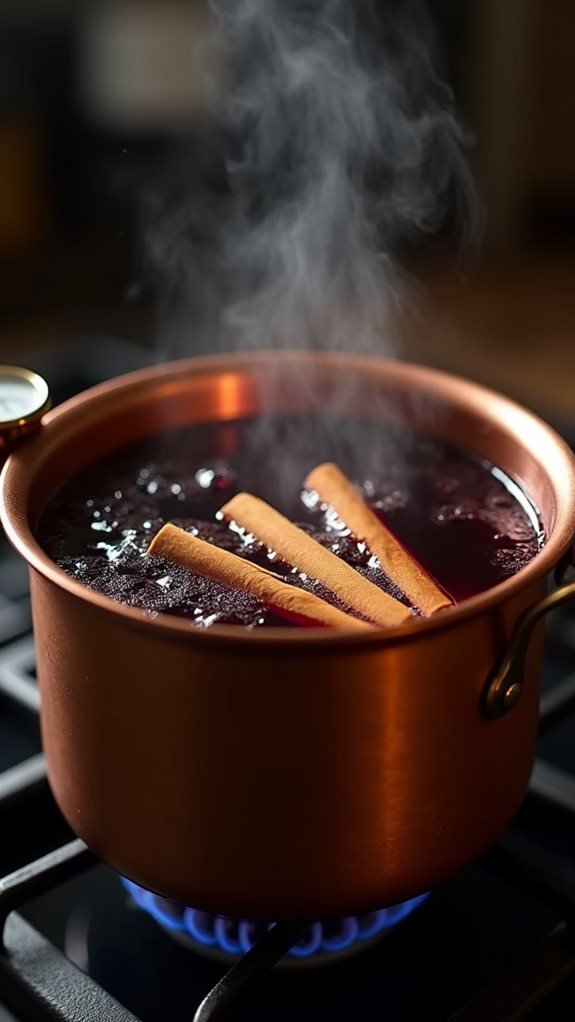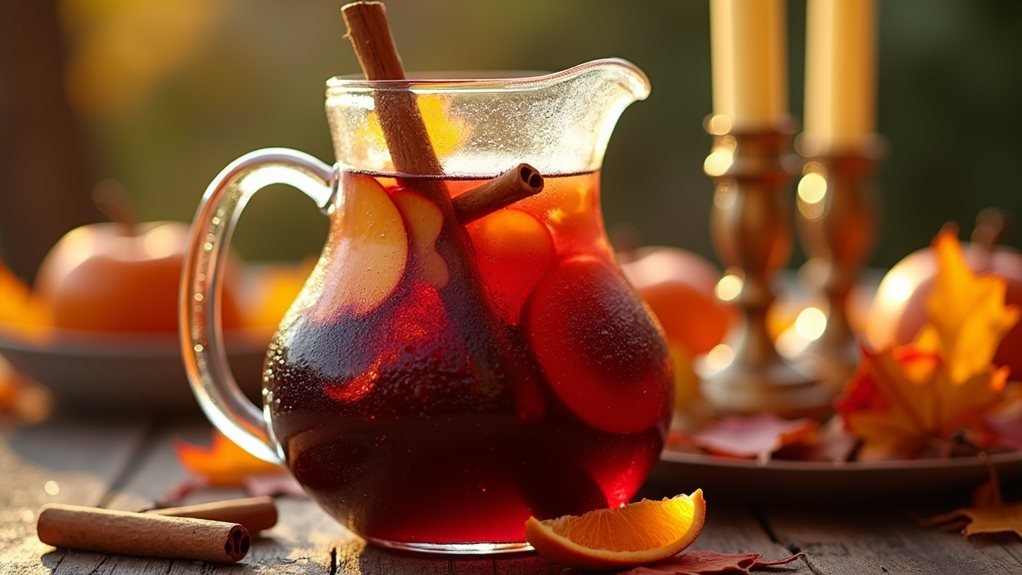You’re about to uncover a remarkable twist on traditional Thanksgiving beverages that combines Gordon Ramsay’s signature mulled wine techniques with the vibrant appeal of Spanish sangria. This innovative drink connects the gap between casual entertainment and culinary sophistication, offering your guests an unexpected choice of standard holiday fare. Whether you’re hosting an intimate gathering or a grand celebration, this warm and spicy concoction will transform your Thanksgiving drink menu from predictable to extraordinary. Let’s delve into how you can master this enhanced holiday beverage that’s quickly becoming a modern classic.
Recipe Insights
- Combine Ramsay’s signature star anise and fresh vanilla pods with traditional sangria spices for enhanced depth and complexity.
- Heat the wine gently with spices at precisely 70°C (160°F) to preserve delicate flavors while extracting aromatics.
- Layer seasonal fruits like Honeycrisp apples and citrus in stages, following Ramsay’s technique of gradual flavor building.
- Finish with a splash of premium cognac and orange liqueur, reflecting Ramsay’s elevated approach to mulled beverages.
- Garnish with caramelized orange slices and fresh cinnamon sticks, presenting the sangria in glass vessels for visual appeal.
History
Sangria came about in Spain and Portugal during the 18th and 19th centuries, though its roots stretch back to ancient Roman times when wine was mixed with water and spices. You’ll find that this early practice wasn’t just about enjoyment – it was a necessity, as water wasn’t always safe to drink. Wine’s natural antimicrobial properties made it a safer choice.
The tradition of mulling wine with spices spread throughout Europe during the Middle Ages, and you’ll notice how different regions developed their variations.
When you create a Thanksgiving sangria, you combine two distinct traditions: the Spanish method of fruit-infused wine and the Northern European custom of mulling wine with warm spices. This fusion perfectly captures the spirit of American Thanksgiving, which itself is a celebration of cultural blending.
During the 1964 World’s Fair in New York, you could find sangria being introduced to mainstream America, and it’s been a popular choice for entertainment ever since. The addition of autumn fruits and warming spices makes it particularly suitable for Thanksgiving celebrations.
Today, many people follow Chef Ramsay’s approach of using cinnamon sticks and spices to create a warming holiday drink that can be prepared well in advance.
Recipe
Thanksgiving Sangria is a refined holiday beverage that transforms traditional mulled wine into a lively autumn drink. This warm and welcoming cocktail combines the rich flavors of Cabernet Sauvignon with seasonal fruits and aromatic spices, creating a perfect accompaniment to holiday festivities.
The success of this sangria relies heavily on the quality of ingredients and precise temperature control during preparation. The union of Honeycrisp apples, fresh orange juice, and honey creates a balanced sweetness, while cinnamon adds a comforting spice note that captures the essence of fall celebrations.
- 2 bottles of Cabernet Sauvignon
- 3 cinnamon sticks
- 2 large Honeycrisp apples, sliced
- 1 cup freshly squeezed orange juice
- 1/4 cup honey
Pour the red wine into a large pot and add cinnamon sticks. Heat the mixture over medium-low heat until warm but not boiling. Stir in the honey until completely dissolved, then remove from heat. Add the sliced apples and orange juice, allowing the mixture to steep for 30 minutes.
For cold service, transfer to a pitcher and refrigerate for at least 2 hours; for warm service, gently reheat the mixture before serving, ensuring it doesn’t reach a boil. Taking inspiration from Ramsay’s culinary artistry, consider adding a splash of balsamic vinegar for enhanced depth and complexity.
To elevate your sangria, prepare the fruit up to 24 hours in advance and store it in an airtight container in the refrigerator. When serving chilled, use frozen apple chunks instead of ice cubes to maintain the drink’s strength while keeping it cold. The sangria can be stored in the refrigerator for up to 48 hours, though the fruit should be strained after 24 hours to prevent over-maceration.
Mixing Steps
You’ll want to start by heating your red wine in a large pot over medium-low heat, introducing the cinnamon sticks and honey while stirring gently to combine.
Once the mixture is warmed through, you can add your fresh apple slices and orange juice, letting everything steep together for the best flavor development.
Before serving either chilled or warm, strain the mixture to remove the cinnamon sticks and fruit pieces. You’re welcome to add fresh fruit garnishes to each glass.
Step 1. Pour Wine, Begin Heating

To begin the warming process, pour both bottles of Cabernet Sauvignon into a large pot or Dutch oven on your stovetop. Make sure there’s enough room for the wine to warm evenly without risking spillage when you stir. Then, drop in the cinnamon sticks, positioning them so they’re fully submerged in the wine.
Set your burner to medium-low heat, which is vital for maintaining the wine’s delicate flavors. You’ll want to monitor the surface of the wine carefully – you’re looking for small bubbles forming around the edges and gentle wisps of steam, but never a rolling boil. If you notice larger bubbles starting to form, immediately lower the heat. This gentle warming process allows the cinnamon to release its oils and flavors without compromising the wine’s alcohol content or taste profile.
As the wine warms, you’ll start to notice the aromatic blend of Cabernet and cinnamon filling your kitchen. This initial heating stage typically takes about 8-10 minutes, during which you should occasionally stir the mixture with a wooden spoon to ensure even heat distribution.
Step 2. Add Spices and Honey

With the wine now warming, it’s time to add the sweetening components. You’ll want to add the cinnamon sticks initially, allowing them to infuse their warm, aromatic essence into the wine. Keep a close eye on the temperature—you’re looking for gentle warmth, not bubbling or boiling, which would compromise both flavor and alcohol content.
Once the wine has reached the ideal temperature, drizzle in the honey while stirring continuously. You’ll notice the honey dissolve more readily in the warm liquid, creating a seamless blend. The honey’s natural sweetness complements the wine’s tannins perfectly, while the cinnamon adds that essential holiday warmth. Don’t rush this process—proper inclusion of these components is vital for achieving the balanced flavor profile that makes this sangria special.
Remember to taste-test as you go, though keep in mind that the flavors will continue to develop during the steeping process. If you’re planning to serve the sangria chilled, you might want to add slightly more honey, as cold temperatures can dull sweetness.
Step 3. Mix in Fruits Gently

Gently fold the sliced Honeycrisp apples into the warm wine mixture, ensuring each piece is fully submerged. You’ll want to handle the fruit with care to prevent breaking or mushing the slices, as their presentation in the final drink will contribute to its visual appeal. Let the apples steep for about 10 minutes before adding the orange juice.
Once you’ve added the orange juice, you’ll notice the mixture taking on a brighter, more complex aroma. Use a wooden spoon to stir the ingredients with slow, deliberate movements. The gentle mixing allows the fruits to release their natural sweetness without becoming overly macerated. If you’re planning to serve the sangria chilled, transfer the mixture to a large glass pitcher and refrigerate for at least 2 hours.
You can prepare this mixture up to 24 hours in advance for the best flavor development. When serving, make sure to include some of the infused fruit pieces in each glass. The apples will have absorbed the wine’s rich flavors while contributing their own crisp, autumn sweetness to the drink.
Step 4. Adjust Sweetness To Taste

Achieving the perfect sweetness level in your Thanksgiving sangria requires careful tasting and adjusting. You’ll want to start with the base honey measurement, but keep in mind that different wines and fruits can affect the overall sweetness profile differently. If you’re using particularly tart apples or a drier wine, you might need to add more honey to balance the flavors.
Test the sweetness after the initial steep, when the flavors have had a chance to meld together. You can add honey in small increments, about one tablespoon at a time, stirring thoroughly and allowing it to dissolve completely before tasting again.
Don’t rush this process – it’s easier to add sweetness than to correct an overly sweet mixture. If you’ve gone too far with the honey, you can balance it by adding a splash more orange juice or wine.
Keep in mind that the sweetness will become more pronounced as the sangria chills, so if you’re serving it cold, aim for slightly less sweetness than you’d prefer in the warm mixture. For warm service, you might need a touch more honey to achieve the same perceived sweetness level.
Step 5. Strain Before Serving

The straining process marks a pivotal final step before serving your Thanksgiving sangria. You’ll want to remove the cinnamon sticks and fruit pieces that have been steeping, ensuring a smooth, sophisticated presentation that’ll impress your guests. Using a fine-mesh strainer, carefully pour the sangria through it into your serving vessel, catching any small fragments or spices that might’ve broken apart during the infusion process.
If you’re serving the sangria warm, strain it while it’s still hot, then transfer it immediately to a thermal carafe or insulated pitcher to maintain the ideal serving temperature.
For cold service, strain the chilled sangria directly into a glass pitcher filled with fresh fruit garnishes. Don’t discard the strained fruit immediately – you can repurpose the wine-soaked apple slices as a delicious garnish for individual glasses.
For an extra touch of refinement, you might consider double-straining through cheesecloth to catch even the finest particles. This results in a crystal-clear presentation that maintains the sangria’s festive color while eliminating any unwanted sediment.
Common Questions About This Recipe
Temperature control remains important – if you’re reheating the sangria, use medium-low heat and never let it boil.
For garnishing, consider adding fresh apple slices and cinnamon sticks just before serving to improve both presentation and aroma.
Final Thoughts and Serving Ideas
Serving this Thanksgiving sangria offers countless opportunities to enrich your holiday gathering. It’s versatile enough to complement both appetizers and main courses, while its distinct profile creates an inviting atmosphere throughout your home.
Consider setting up a dedicated beverage station where guests can serve themselves, complete with garnish options like fresh apple slices and cinnamon sticks.
For a refined presentation, you’ll want to use clear glass pitchers or a traditional sangria vessel that showcases the drink’s rich color and floating fruit. If you’re serving it warm, consider using a slow cooker set to low heat to maintain the perfect temperature throughout your event.
Remember to provide appropriate glassware—wine glasses for a formal setting or festive mason jars for a more casual affair.
You can also create a non-alcoholic version by substituting the wine with cranberry juice and grape juice in equal parts. This ensures all your guests can participate in the seasonal celebration while enjoying the same warm, spiced flavors that make this beverage uniquely suited for Thanksgiving entertaining.







